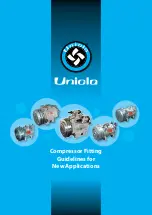
47612267 Rev B
EN-5
EN
ROUTINE MAINTENANCE
This section refers to the various components which require
periodic maintenance and replacement.
Refer to safety information and maintenance procedures
prior to carrying out any of the maintenance in the following
sections.
NOTICE
Prior to opening or removing panels or covers to work
inside a machine, ensure that anyone entering the
machine is aware of the reduced level of protection
and the additional hazards, including hot surfaces and
intermittently moving parts.
CHECKING COOLANT LEVEL
A coolant level sight glass is located on the side of the
separator tank. While the compressor is running under load,
coolant should always be visible in the sight glass. The normal
position is half way. The compressor should be running for at
least 40 seconds for this check.
Stop the compressor, ensure the sump pressure is 0 psig and
ensure the coolant is still visible in the sight glass.
ADDING COOLANT
Run the compressor for a minimum of 40 seconds. The
coolant level should be visible in the sight glass. If not:
1. Stop the compressor.
2. Isolate the compressor from the external air system.
3. Press the emergency stop. Compressors can take
more than two minutes to fully de-pressurize once
stopped.
4. Slowly unscrew the coolant fill plug to verify all
pressure has been released.
5. Add coolant.
6. Replace the coolant fill plug and restart the
compressor.
7. Recheck the coolant level.
8. Repeat the above steps until the coolant level is
visible in the sight glass with the compressor both
running and stopped.
NOTICE
Do not add coolant through the intake of the
compressor, as this can result in overfilling, saturation
of the separator filter element, and coolant carry-over
downstream.
DRAINING COOLANT
It is better to drain the coolant immediately after the
compressor has been operating as the coolant will drain
faster and any contaminant will still be in suspension.
See Figure 1.
1. Place the straight end of the drain hose in a suitable
container. Install the other end of the drain hose in
the drain valve. The coolant flows through the drain
hose automatically.
2. After drainage, remove the hose and close the valve.
NOTICE
You may also drain coolant from the coolant cooler by
removing the plug.
You should also drain additional coolant from the
airend by using drain hose.
Figure 1: Coolant Drain
1
2
3
4
3. Dispose of waste coolant in accordance with local and
governmental regulations.
NOTICE
Shorter coolant change intervals may be necessary if
the compressor is operated in adverse conditions.
NOTICE
Inspect and replace coolant filter elements and separator elements more frequently in dirty operating environments.
RELEASED 11/Feb/2019 01:43:20 GMT

































